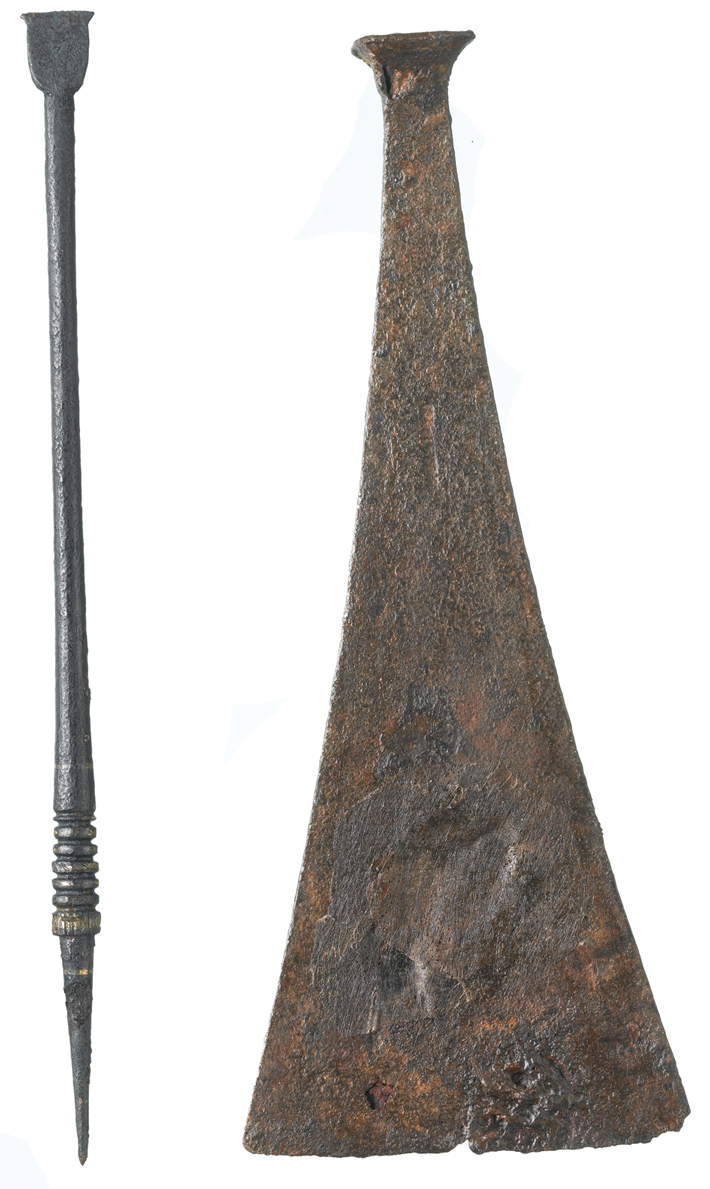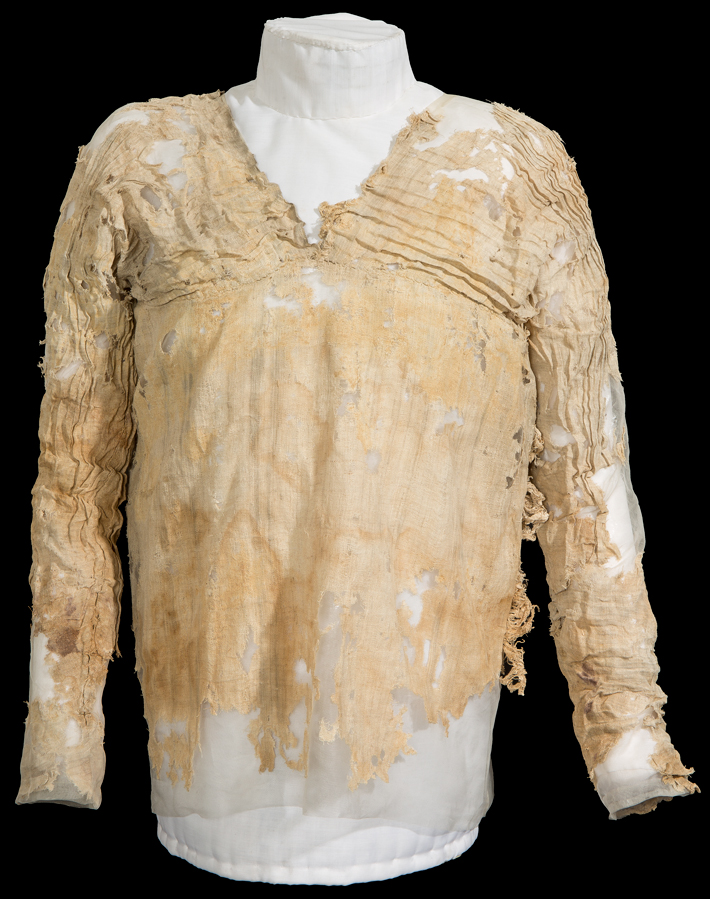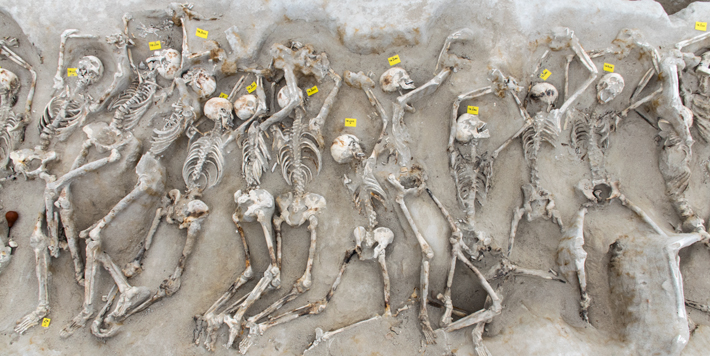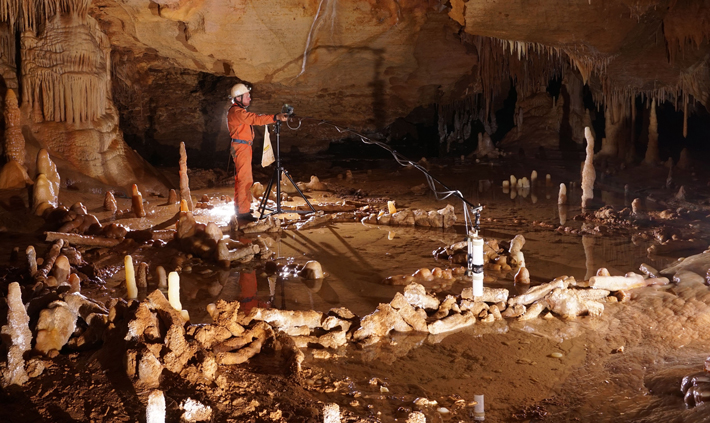Top 10
London’s Earliest Writing
By JASON URBANUS
Monday, December 12, 2016

The largest and most significant collection of Roman waxed writing tablets is providing an intriguing glimpse into life in early Roman London. More than 400 wooden tablets were unearthed by archaeologists from Museum of London Archaeology (MOLA) during excavations at the site of the Bloomberg company’s new European headquarters. Roman London (called Londinium) was founded around A.D. 50, and the recovered texts, written by ordinary residents, record various names, as well as events and transactions that took place during the settlement’s first few decades.
 The tablets, which began to be published in 2016, feature a once-popular method of Roman writing that involved using a pointed stylus to etch letters into a thin layer of wax that had been spread onto a small plank. Since tablets such as these were typically made of wood, they rarely survive. However, the Bloomberg excavation site is located along what used to be the Walbrook River. Most of the tablets discovered there were part of an ancient garbage dump that was used to fill in the wetlands to create buildable land during the Roman era. The muddy, oxygen-free conditions were instrumental in the preservation of the nearly 2,000-year-old tablets. Although the actual inscriptions in wax have long since disappeared, sometimes an overly aggressive scribe applied too much pressure and accidentally etched their writing into the wood beneath the wax.
The tablets, which began to be published in 2016, feature a once-popular method of Roman writing that involved using a pointed stylus to etch letters into a thin layer of wax that had been spread onto a small plank. Since tablets such as these were typically made of wood, they rarely survive. However, the Bloomberg excavation site is located along what used to be the Walbrook River. Most of the tablets discovered there were part of an ancient garbage dump that was used to fill in the wetlands to create buildable land during the Roman era. The muddy, oxygen-free conditions were instrumental in the preservation of the nearly 2,000-year-old tablets. Although the actual inscriptions in wax have long since disappeared, sometimes an overly aggressive scribe applied too much pressure and accidentally etched their writing into the wood beneath the wax.
“The collection is hugely significant,” says MOLA archaeologist Sophie Jackson, “because the tablets date to the first few years of London. They provide new insights into the people who lived, worked, and traded there and administered the new city, and what social, economic, and legal structures were in place.”
Thus far, 19 of the 405 tablets have been decoded through an exacting process that uses multidirectional photography and microscopic analysis. Among these are Britain’s oldest handwritten document and the earliest known reference to Londinium. Some texts appear to be legal records and contracts, while others are correspondence. And one tablet, which simply contains the alphabet, may have been part of a school lesson.
Angkor Urban Sprawl
By NIKHIL SWAMINATHAN
Monday, December 12, 2016

Researchers in northwestern Cambodia have carried out the largest airborne laser-scanning archaeological project to date. They used lidar to survey 900 square miles of the densely forested Angkor region, revealing centuries-old cities that once belonged to the vast Khmer Empire.
The kingdom’s provincial centers turn out to have many characteristics in common with Angkor, the metropolis surrounding the iconic Angkor Wat temple. All share a checkerboard of city blocks within a central moat, enormous reservoirs and canals used for water management, and mysterious mounds and “coiled” embankments built into the earth and seen at every eleventh- and twelfth-century temple site.
Archaeologist Damian Evans had spent a decade searching for evidence of an industrial city at a site east of Angkor called Preah Khan of Kompong Svay. When he looked at the new survey unobscured by vegetation, the three-mile-by-three-mile enclosed urban grid—the largest in Southeast Asia—appeared in plain sight. “It reveals this degree of complexity—the scope and scale at which human beings adapted the environment,” he says. “That’s what lidar illuminated so beautifully in Cambodia.”
World’s Oldest Dress
By JARRETT A. LOBELL
Monday, December 12, 2016
 It’s almost impossible to imagine that an item of clothing worn thousands of years ago has survived to the present day. But the “Tarkhan Dress,” named for the town in Egypt where it was found in 1913, has endured—and has now been precisely dated using the latest radiocarbon dating technology. Researchers have determined that the very finely made linen apparel dates to between 3482 and 3103 B.C., making it the world’s oldest woven garment. Alice Stevenson, curator at the Petrie Museum of Egyptian Archaeology, says, “The dress has provided people with a real sense of the antiquity and longevity of the ancient Egyptian state and society.” To read more about research on the dress, go to “Dressing for the Ages,” from the May/June 2016 issue.
It’s almost impossible to imagine that an item of clothing worn thousands of years ago has survived to the present day. But the “Tarkhan Dress,” named for the town in Egypt where it was found in 1913, has endured—and has now been precisely dated using the latest radiocarbon dating technology. Researchers have determined that the very finely made linen apparel dates to between 3482 and 3103 B.C., making it the world’s oldest woven garment. Alice Stevenson, curator at the Petrie Museum of Egyptian Archaeology, says, “The dress has provided people with a real sense of the antiquity and longevity of the ancient Egyptian state and society.” To read more about research on the dress, go to “Dressing for the Ages,” from the May/June 2016 issue.
Regime Change in Athens
By JARRETT A. LOBELL
Monday, December 12, 2016

The end of the seventh century B.C. was a tumultuous period in Athenian history. Though once ruled by a king, the increasingly powerful region of Attica, home to Athens, had come to be presided over by aristocrats who maintained their hold on power through landownership and lifetime appointments. But as the century drew to a close, the political climate was primed for a new type of government—that of a single ruler, or tyrant. An evocative gravesite on the outskirts of Athens is a testament to this contentious moment in history.
Excavators at the Phaleron Delta necropolis have uncovered the remains of 80 men, shackled together at their wrists, lying in a mass grave. The most recent osteological studies have determined that the majority of the men were between 20 and 30 years old, although four were much younger, and that all 80 had been killed in the same manner—with a fatal blow to the head. The discovery of two small vases buried with them has allowed archaeologists to date the grave to the mid-to-late seventh century B.C., suggesting to project director Stella Chrysoulaki that the men were executed in the course of one of these attempts to gain political primacy. “For the first time,” Chrysoulaki says, “we can illustrate historical events that took place during the struggle between aristocrats in the seventh century and led, through a long process, to the establishment of a democratic regime in the city of Athens.”
Early Man Cave
By DANIEL WEISS
Monday, December 12, 2016

A fifth of a mile inside Bruniquel Cave in southwestern France, a chamber holds several enigmatic ring-shaped structures made from whole and broken stalagmites. Radiocarbon dating of a burned bear bone found among them initially suggested they date to around 47,000 years ago. But this year, uranium-thorium dating that focused on the stalagmite tips and deposits that accumulated on them after they were broken found the structures were actually built around 176,000 years ago. Researchers concluded that since Neanderthals were the only humans living in the area at the time, they must have assembled them. “When we first got this date, I thought it was unbelievable,” says Jacques Jaubert, an archaeologist at the University of Bordeaux. “We had no idea that Neanderthals were operating so deep inside caves at this time.” While the structures also provide evidence of group collaboration, the reason they were built remains a mystery.
Advertisement
Advertisement
IN THIS ISSUE
Advertisement

Recent Issues
-
 May/June 2024
May/June 2024
-
 March/April 2024
March/April 2024
-
 January/February 2024
January/February 2024
-
 November/December 2023
November/December 2023
-
 September/October 2023
September/October 2023
-
 July/August 2023
July/August 2023
-
 May/June 2023
May/June 2023
-
 March/April 2023
March/April 2023
-
 January/February 2023
January/February 2023
-
 November/December 2022
November/December 2022
-
 September/October 2022
September/October 2022
-
 July/August 2022
July/August 2022
-
 May/June 2022
May/June 2022
-
 March/April 2022
March/April 2022
-
 January/February 2022
January/February 2022
-
 November/December 2021
November/December 2021
-
 September/October 2021
September/October 2021
-
 July/August 2021
July/August 2021
-
 May/June 2021
May/June 2021
-
 March/April 2021
March/April 2021
-
 January/February 2021
January/February 2021
-
 November/December 2020
November/December 2020
-
 September/October 2020
September/October 2020
-
 July/August 2020
July/August 2020
-
 May/June 2020
May/June 2020
-
 March/April 2020
March/April 2020
-
 January/February 2020
January/February 2020
-
 November/December 2019
November/December 2019
-
 September/October 2019
September/October 2019
-
 July/August 2019
July/August 2019
-
 May/June 2019
May/June 2019
-
 March/April 2019
March/April 2019
-
 January/February 2019
January/February 2019
-
 November/December 2018
November/December 2018
-
 September/October 2018
September/October 2018
-
 July/August 2018
July/August 2018
-
 May/June 2018
May/June 2018
-
 March/April 2018
March/April 2018
-
 January/February 2018
January/February 2018
-
 November/December 2017
November/December 2017
-
 September/October 2017
September/October 2017
-
 July/August 2017
July/August 2017
-
 May/June 2017
May/June 2017
-
 March/April 2017
March/April 2017
-
 January/February 2017
January/February 2017
-
 November/December 2016
November/December 2016
-
 September/October 2016
September/October 2016
-
 July/August 2016
July/August 2016
-
 May/June 2016
May/June 2016
-
 March/April 2016
March/April 2016
-
 January/February 2016
January/February 2016
-
 November/December 2015
November/December 2015
-
 September/October 2015
September/October 2015
-
 July/August 2015
July/August 2015
-
 May/June 2015
May/June 2015
-
 March/April 2015
March/April 2015
-
 January/February 2015
January/February 2015
-
 November/December 2014
November/December 2014
-
 September/October 2014
September/October 2014
-
 July/August 2014
July/August 2014
-
 May/June 2014
May/June 2014
-
 March/April 2014
March/April 2014
-
 January/February 2014
January/February 2014
-
 November/December 2013
November/December 2013
-
 September/October 2013
September/October 2013
-
 July/August 2013
July/August 2013
-
 May/June 2013
May/June 2013
-
 March/April 2013
March/April 2013
-
 January/February 2013
January/February 2013
-
 November/December 2012
November/December 2012
-
 September/October 2012
September/October 2012
-
 July/August 2012
July/August 2012
-
 May/June 2012
May/June 2012
-
 March/April 2012
March/April 2012
-
 January/February 2012
January/February 2012
-
 November/December 2011
November/December 2011
-
 September/October 2011
September/October 2011
-
 July/August 2011
July/August 2011
-
 May/June 2011
May/June 2011
-
 March/April 2011
March/April 2011
-
 January/February 2011
January/February 2011
Advertisement






